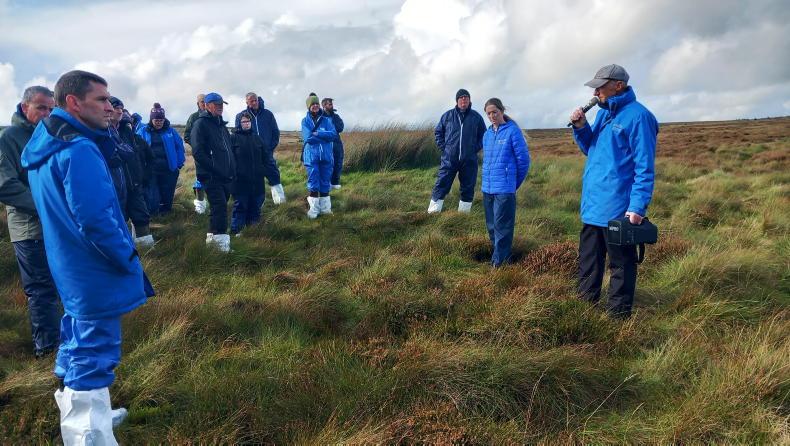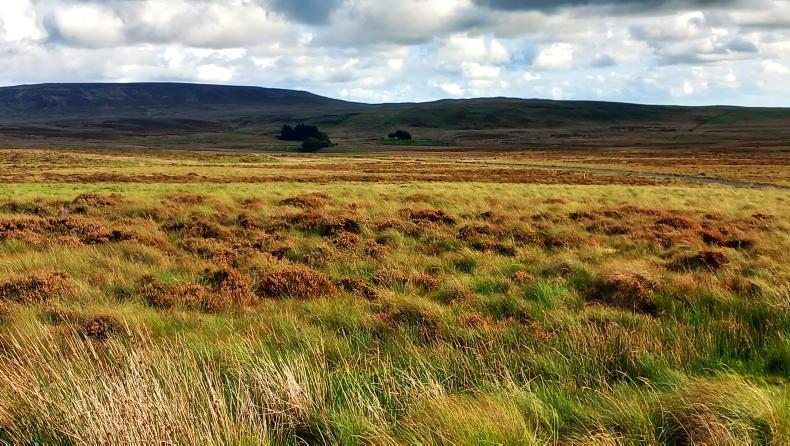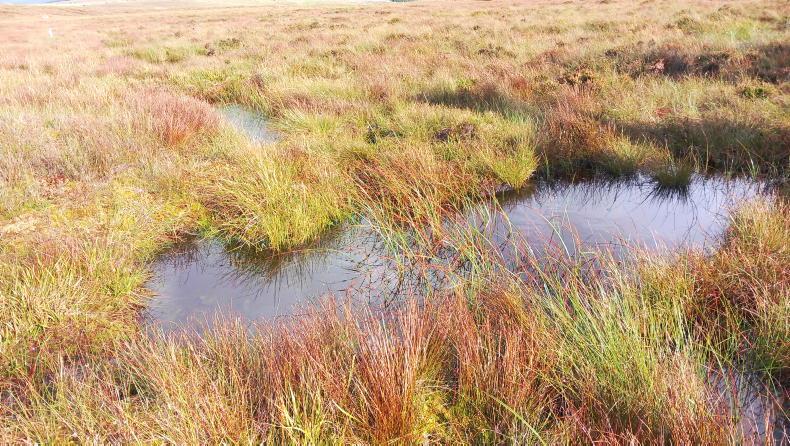A group of 25 suckler cows are being out-wintered on Greenmount’s Hill Farm in Glenwherry, Co Antrim, to help improve habitat for birds.
In the past, staff at CAFRE used tractors with flail mowers to open up areas of dense vegetation, to make sites more suitable for breeding waders to nest and feed.
However, spring-calving sucklers are now being grazed on parts of the hill throughout winter, to improve the condition of the habitat.
Cattle are better than sheep at maintaining the breeding wader sites, as they are non-selective grazers – so more vegetation is cleaned off with each bite.
During a recent visit, members of the Institute of Agricultural Management (IAgM) were told that the new approach to habitat management has brought a wide range of benefits.
Firstly, using cows to manage the vegetation rather than tractors is cheaper and requires no fossil fuel inputs.
With 25 less cows in the shed, it significantly reduces demand on silage and slurry storage. Less slurry in the tank also means a reduction in ammonia emissions.
IAgM members were told that the habitat created by cows is more favourable for breeding waders than the sites that were flailed by mowers. It was highlighted that dung pats and hoof marks are excellent for insect life, which are an essential part of the ecosystem.

CAFRE's Bryan Irvine speaking to IAgM members in Glenwherry.
Three-way cross
In total, there are 100 sucklers on Greenmount’s Hill Farm, which are bred in a three-way cross of Aberdeen Angus, Shorthorn and Limousin genetics.
Cows becoming too fat over the winter can be an issue on the farm and so out-wintering is used to help get cows into optimal condition before spring.
Farm manager Michael Graham said that “the fleshiest cows with the biggest calves” are selected in November for out-wintering.
These cows have their calves weaned a few weeks earlier than the rest of the herd and, as a result, their calves consume an extra 50kg of concentrates over winter.
However, Graham said the extra expense of this is more than outweighed by financial savings from the cows eating less silage and producing less slurry. The cows are not fed supplementary silage or meal during the winter, because this would damage the vegetation and soil at feeding sites. Lick buckets are offered and are moved regularly.
“Cows need to be out from the start of the winter. If you turned them out of the shed mid-way through the winter, they would stand at the gate,” Graham maintained.

CAFRE's Hill Farm runs to 1,040 hectares and just 5% of the area is improved grassland.
Fitter cows
CAFRE staff have found that by the springtime, the out-wintered cows tend to be fitter and have fewer calving difficulties than the cows that are housed all winter.
Newborn calves from the out-wintered cows are usually slightly smaller, although Graham said this makes no difference to the performance of the calves as the spring and summer progresses.
Another indirect benefit of out-wintering surrounds the drop in silage requirements. Only one cut of silage was needed on the Hill Farm this year, which meant more good-quality grass was available for grazing during the summer and autumn.
“We were able to finish 160 lambs on the Hill Farm this summer. Most other years we only finished 20 or 30 lambs and the rest were sold as stores. We have more grass for flushing ewes now too,” Graham said.
GPS collars used for conservation grazing
The cows that stay on the breeding wader habitat during the winter wear GPS collars to control where they can graze.
A “virtual fence” is set up on a mobile app and the GPS collars produce a high-pitched noise as cows approach the invisible boundary.
The noise gets louder the closer the cow comes to the fence line and the collar gives off an electric shock if she crosses the line.
Bryan Irvine from CAFRE said local research on GPS collars conducted at the Agri Food and Biosciences Institute found no issues with animal welfare.
The study found there was no difference in levels of the stress hormone cortisol in cattle when GPS collars were used compared to conventional electric fences. Irvine said most cows with the GPS collars quickly learn to turn back when they hear the high-pitched noise as they approach the fence line.
Each collar weighs 1.5kg and is fitted with solar panels, so regular battery changes are not required. The technology also provides information on the behaviour of each cow, including the time spent grazing and lying down. At present, each collar costs £300, so the technology is still too expensive for most commercial farms.
However, it was suggested that the conservation grazing benefits could potentially be used as a means to justify grant funding for GPS collars in the future.

There are a range of techniques for blocking drains to rewet bog.
Grazing rewetted bog land at Glenwherry
Several areas of blanket bog on the CAFRE Hill Farm have been rewetted in recent years.
The aim is to raise the water table within 10cm of the surface, to help improve the environmental condition of the bog.
In particular, a key objective is to ensure that rather than being a source of emissions, the bog land removes carbon dioxide from the atmosphere through sequestration.
During a recent visit, IAgM members were told a range of techniques can be used to effectively block drains and slow the release of water from bogland. It typically costs around £300/ha to carry out the work with diggers.
Livestock are still grazing the re-wetted bogs in Glenwherry at certain times of the year and there has been no change in overall livestock numbers on the farm.
That said, stocking rates are very light and even before drains were blocked, blanket bog on the farm was not heavily stocked.
For example, a 60ha block previously grazed 60 Blackface ewes and their lambs. It has now been rewetted and grazes 48 hoggets at a stocking rate which equates to 0.04 livestock units per hectare over the course of the year.
Eileen McCloskey from CAFRE pointed out that livestock are essential for maintaining upland habitats on the farm, whilst also producing a saleable product in the form of store cattle and lambs.
“If there was no management, it would be a shrub habitat and it would not be as beneficial for birds and insects,” she said.
For comparison reasons, a nine-hectare block of heathland has been fenced off at Glenwherry and is not being managed by either livestock grazing, burning, or flailing.
Bryan Irvine from CAFRE said the heather has grown stemmy and is now well above knee height. He suggested it was not a model for the uplands, describing it as “a massive wildfire risk”.
Need for NI-specific greenhouse emissions figures
Equipment has been installed on the CAFRE Hill Farm to accurately measure changes in greenhouse gas emissions.
At present, broad brush emission factors for the whole of the UK are used when calculating the amount of greenhouse gases that are emitted or sequestered from different types of land. However, CAFRE’s Bryan Irvine said there is a need for more detailed local figures, as conditions can vary widely across the UK, and even within NI.
The example was given of an area of bogland in Glenwherry, which under the UK figures is assumed to be emitting three tonnes of carbon dioxide equivalents per hectare (tCO2e/ha).
However, the new equipment found that the actual figure was -3.7 tCO2e/ha, which means carbon is being removed from the atmosphere, not emitted.
Even when methane emissions from the livestock that graze the site are factored in, as well as carbon that is lost through water run-off, the bog is still managing to sequester 0.18 tCO2e/ha.
A group of 25 suckler cows are being out-wintered on Greenmount’s Hill Farm in Glenwherry, Co Antrim, to help improve habitat for birds.
In the past, staff at CAFRE used tractors with flail mowers to open up areas of dense vegetation, to make sites more suitable for breeding waders to nest and feed.
However, spring-calving sucklers are now being grazed on parts of the hill throughout winter, to improve the condition of the habitat.
Cattle are better than sheep at maintaining the breeding wader sites, as they are non-selective grazers – so more vegetation is cleaned off with each bite.
During a recent visit, members of the Institute of Agricultural Management (IAgM) were told that the new approach to habitat management has brought a wide range of benefits.
Firstly, using cows to manage the vegetation rather than tractors is cheaper and requires no fossil fuel inputs.
With 25 less cows in the shed, it significantly reduces demand on silage and slurry storage. Less slurry in the tank also means a reduction in ammonia emissions.
IAgM members were told that the habitat created by cows is more favourable for breeding waders than the sites that were flailed by mowers. It was highlighted that dung pats and hoof marks are excellent for insect life, which are an essential part of the ecosystem.

CAFRE's Bryan Irvine speaking to IAgM members in Glenwherry.
Three-way cross
In total, there are 100 sucklers on Greenmount’s Hill Farm, which are bred in a three-way cross of Aberdeen Angus, Shorthorn and Limousin genetics.
Cows becoming too fat over the winter can be an issue on the farm and so out-wintering is used to help get cows into optimal condition before spring.
Farm manager Michael Graham said that “the fleshiest cows with the biggest calves” are selected in November for out-wintering.
These cows have their calves weaned a few weeks earlier than the rest of the herd and, as a result, their calves consume an extra 50kg of concentrates over winter.
However, Graham said the extra expense of this is more than outweighed by financial savings from the cows eating less silage and producing less slurry. The cows are not fed supplementary silage or meal during the winter, because this would damage the vegetation and soil at feeding sites. Lick buckets are offered and are moved regularly.
“Cows need to be out from the start of the winter. If you turned them out of the shed mid-way through the winter, they would stand at the gate,” Graham maintained.

CAFRE's Hill Farm runs to 1,040 hectares and just 5% of the area is improved grassland.
Fitter cows
CAFRE staff have found that by the springtime, the out-wintered cows tend to be fitter and have fewer calving difficulties than the cows that are housed all winter.
Newborn calves from the out-wintered cows are usually slightly smaller, although Graham said this makes no difference to the performance of the calves as the spring and summer progresses.
Another indirect benefit of out-wintering surrounds the drop in silage requirements. Only one cut of silage was needed on the Hill Farm this year, which meant more good-quality grass was available for grazing during the summer and autumn.
“We were able to finish 160 lambs on the Hill Farm this summer. Most other years we only finished 20 or 30 lambs and the rest were sold as stores. We have more grass for flushing ewes now too,” Graham said.
GPS collars used for conservation grazing
The cows that stay on the breeding wader habitat during the winter wear GPS collars to control where they can graze.
A “virtual fence” is set up on a mobile app and the GPS collars produce a high-pitched noise as cows approach the invisible boundary.
The noise gets louder the closer the cow comes to the fence line and the collar gives off an electric shock if she crosses the line.
Bryan Irvine from CAFRE said local research on GPS collars conducted at the Agri Food and Biosciences Institute found no issues with animal welfare.
The study found there was no difference in levels of the stress hormone cortisol in cattle when GPS collars were used compared to conventional electric fences. Irvine said most cows with the GPS collars quickly learn to turn back when they hear the high-pitched noise as they approach the fence line.
Each collar weighs 1.5kg and is fitted with solar panels, so regular battery changes are not required. The technology also provides information on the behaviour of each cow, including the time spent grazing and lying down. At present, each collar costs £300, so the technology is still too expensive for most commercial farms.
However, it was suggested that the conservation grazing benefits could potentially be used as a means to justify grant funding for GPS collars in the future.

There are a range of techniques for blocking drains to rewet bog.
Grazing rewetted bog land at Glenwherry
Several areas of blanket bog on the CAFRE Hill Farm have been rewetted in recent years.
The aim is to raise the water table within 10cm of the surface, to help improve the environmental condition of the bog.
In particular, a key objective is to ensure that rather than being a source of emissions, the bog land removes carbon dioxide from the atmosphere through sequestration.
During a recent visit, IAgM members were told a range of techniques can be used to effectively block drains and slow the release of water from bogland. It typically costs around £300/ha to carry out the work with diggers.
Livestock are still grazing the re-wetted bogs in Glenwherry at certain times of the year and there has been no change in overall livestock numbers on the farm.
That said, stocking rates are very light and even before drains were blocked, blanket bog on the farm was not heavily stocked.
For example, a 60ha block previously grazed 60 Blackface ewes and their lambs. It has now been rewetted and grazes 48 hoggets at a stocking rate which equates to 0.04 livestock units per hectare over the course of the year.
Eileen McCloskey from CAFRE pointed out that livestock are essential for maintaining upland habitats on the farm, whilst also producing a saleable product in the form of store cattle and lambs.
“If there was no management, it would be a shrub habitat and it would not be as beneficial for birds and insects,” she said.
For comparison reasons, a nine-hectare block of heathland has been fenced off at Glenwherry and is not being managed by either livestock grazing, burning, or flailing.
Bryan Irvine from CAFRE said the heather has grown stemmy and is now well above knee height. He suggested it was not a model for the uplands, describing it as “a massive wildfire risk”.
Need for NI-specific greenhouse emissions figures
Equipment has been installed on the CAFRE Hill Farm to accurately measure changes in greenhouse gas emissions.
At present, broad brush emission factors for the whole of the UK are used when calculating the amount of greenhouse gases that are emitted or sequestered from different types of land. However, CAFRE’s Bryan Irvine said there is a need for more detailed local figures, as conditions can vary widely across the UK, and even within NI.
The example was given of an area of bogland in Glenwherry, which under the UK figures is assumed to be emitting three tonnes of carbon dioxide equivalents per hectare (tCO2e/ha).
However, the new equipment found that the actual figure was -3.7 tCO2e/ha, which means carbon is being removed from the atmosphere, not emitted.
Even when methane emissions from the livestock that graze the site are factored in, as well as carbon that is lost through water run-off, the bog is still managing to sequester 0.18 tCO2e/ha.









 This is a subscriber-only article
This is a subscriber-only article










SHARING OPTIONS: